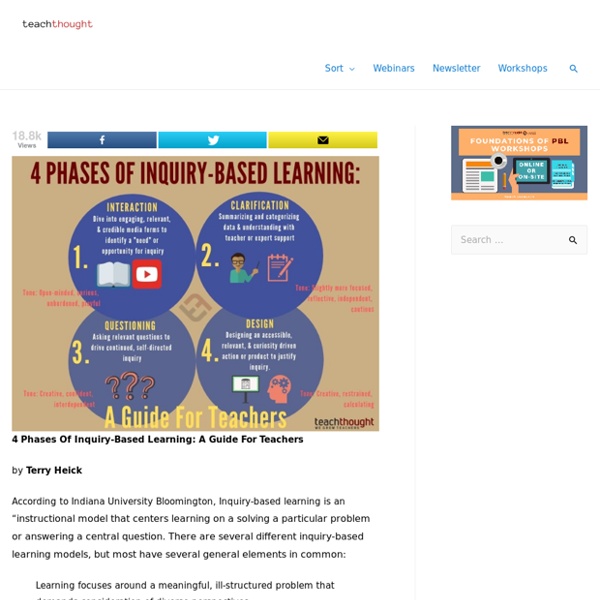What is Inquiry-Based Learning (And How Is It Effective)?
The key to success for students is making sure they are engaged with any material they are learning. Sometimes, that’s easier said than done. For many students, the traditional classroom approach leaves them bored and unengaged. As a result, they aren’t effectively learning (or understanding) the material being taught.
Resources and Downloads to Facilitate Inquiry-Based Learning
A Case for Curiosity: Hear from one educator on the value of asking “why?” and learn how to preserve and nurture a curious mindset. (Edutopia, 2016) 3 Rules to Spark Learning: Watch a short video to understand how student questions seed real learning. (TED Talks, 2013) Why Curiosity Enhances Learning: Read about findings of a neurological study on curiosity.
Research Process Models
We know from decades of studies that when people do research, they follow a process with some predictable stages. There are many models of this process. Here are three. As you read, think about what these models have in common. The Search Process Model 1
CoI Framework
An educational community of inquiry is a group of individuals who collaboratively engage in purposeful critical discourse and reflection to construct personal meaning and confirm mutual understanding. The Community of Inquiry theoretical framework represents a process of creating a deep and meaningful (collaborative-constructivist) learning experience through the development of three interdependent elements – social, cognitive and teaching presence. Social presence is “the ability of participants to identify with the community (e.g., course of study), communicate purposefully in a trusting environment, and develop inter-personal relationships by way of projecting their individual personalities.” (Garrison, 2009) Teaching Presence is the design, facilitation, and direction of cognitive and social processes for the purpose of realizing personally meaningful and educationally worthwhile learning outcomes (Anderson, Rourke, Garrison, & Archer, 2001). Garrison, D.
5 Ways to Help Your Students Become Better Questioners
The humble question is an indispensable tool: the spade that helps us dig for truth, or the flashlight that illuminates surrounding darkness. Questioning helps us learn, explore the unknown, and adapt to change. That makes it a most precious “app” today, in a world where everything is changing and so much is unknown. And yet, we don’t seem to value questioning as much as we should. For the most part, in our workplaces as well as our classrooms, it is the answers we reward -- while the questions are barely tolerated. To change that is easier said than done.
GREENRGY HOME
When your grandparents pulled up to the gas pump, there was basically one choice: leaded ethyl. Gasoline containing lead contaminated the environment and was eventually banned. It hasn't been sold at gas stations (legally) in the United States since 1995. A more environmentally-friendly, unleaded alternative was needed.
TPACK: Technological Pedagogical Content Knowledge Framework
Share on StumbleUpon0 shares on StumbleUpon Courses & Certification Instructional Design Certificate (Fully Online). This fully online program is for anyone developing and/or teaching an online course.
Compelling Questions and Stultifying Questions
Some questions are more powerful, more important and more engaging than others. Some are quite boring. They will cause students to "lose enthusiasm and initiative, especially as a result of a tedious or restrictive routine." (Quoting from the Apple Dictionary's definition of "stultify.") The failure to know the difference between compelling and stultifying can undermine the success of even the most ambitious and well intended reform effort.
Dimensions of Inquiry - Galileo Educational Network
Dimensions of Inquiry Galileo Educational Network October 21, 2016 Focus On Inquiry Research Series and Dimensions of Inquiry When inquiry is front and center, teachers and students discover that each discipline, or area of study, has its own way of investigating, bringing forward evidence, communicating and generating knowledge. As we’ve mentioned before, discipline-based inquiry is a distinctive way of thinking about the world.



